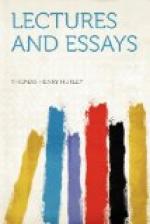And, all the while, the scientific student of theology knows that, the more reason there may be to believe that Luke was the companion of Paul, the more doubtful becomes his credibility, if he really wrote the Acts. For, in that case, he could not fail to have been acquainted with Paul’s account of the Jerusalem conference, and he must have consciously misrepresented it.
We may next turn to the essential part of Dr. Wace’s citation (Nineteenth Century, p. 365) touching the first Gospel:—
St. Matthew evidently
deserves peculiar confidence for the
discourses. Here
are the “oracles”—the very notes
taken while the
memory of the instruction
of Jesus was living and definite.
M. Renan here expresses the very general opinion as to the existence of a collection of “logia,” having a different origin from the text in which they are embedded, in Matthew. “Notes” are somewhat suggestive of a shorthand writer, but the suggestion is unintentional, for M. Renan assumes that these “notes” were taken, not at the time of the delivery of the “logia” but subsequently, while (as he assumes) the memory of them was living and definite; so that, in this very citation, M. Renan leaves open the question of the general historical value of the first Gospel; while it is obvious that the accuracy of “notes” taken, not at the time of delivery, but from memory, is a matter about which more than one opinion may be fairly held. Moreover, Renan expressly calls attention to the difficulty of distinguishing the authentic “logia” from later additions of the same kind ("Les Evangiles,” p. 201). The fact is, there is no contradiction here to that opinion about the first Gospel which is expressed in “Les Evangiles” (p. 175).
The text of the so-called Matthew supposes the pre-existence of that of Mark, and does little more than complete it. He completes it in two fashions—first, by the insertion of those long discourses which gave their chief value to the Hebrew Gospels; then by adding traditions of a more modern formation, results of successive developments of the legend, and to which the Christian consciousness already attached infinite value.
M. Renan goes on to suggest that besides “Mark,” “Pseudo-Matthew” used an Aramaic version of the Gospel, originally set forth in that dialect. Finally, as to the second Gospel (Nineteenth Century, p. 365):—
He [Mark] is full of minute observations, proceeding, beyond doubt, from an eye-witness. There is nothing to conflict with the supposition that this eye-witness ... was the Apostle Peter himself, as Papias has it.
Let us consider this citation by the light of “Les Evangiles":—
This work, although
composed after the death of Peter, was, in a
sense, the work of Peter;
it represents the way in which Peter was
accustomed to relate
the life of Jesus (p. 116).




